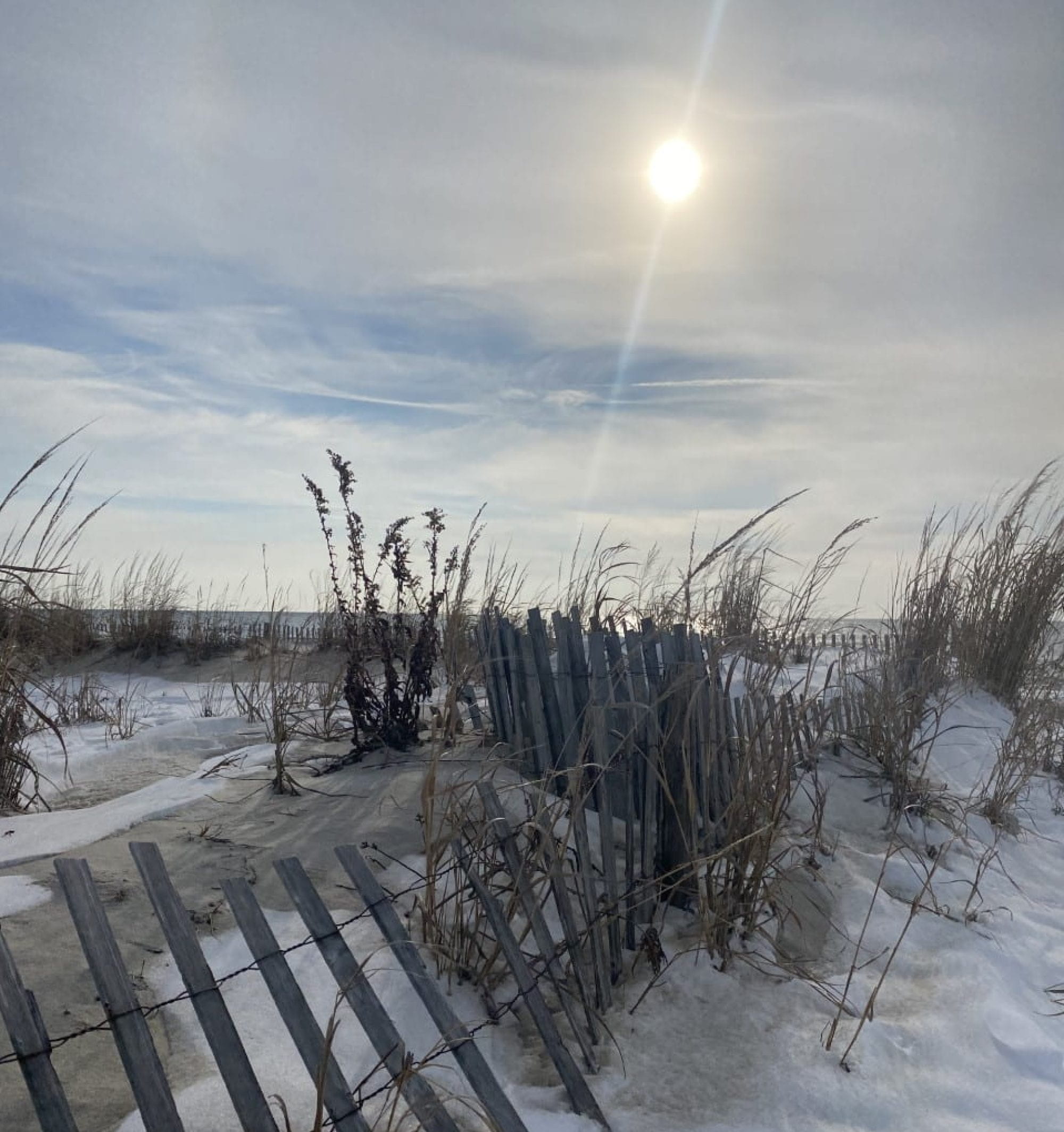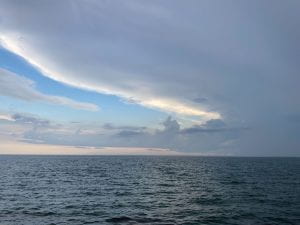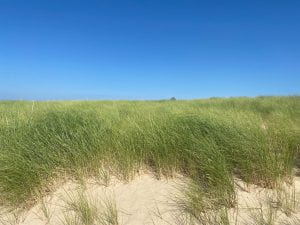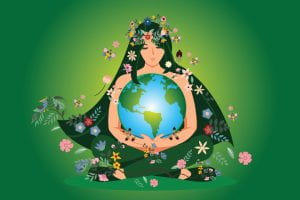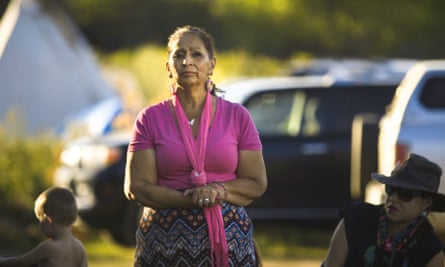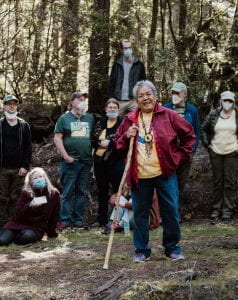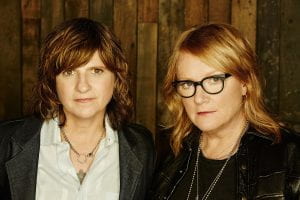
When I look at this image, I am reminded of two things. One is that meat is typically represented by masculine images and in this case, it is evident. The second is that it is another way in which patriarchal ideology has indoctrinated itself in other aspects of life when we look at both human and our non-human friends in terms of their treatment and placement in society which has resulted in their oppression.
At first glance one’s attention is drawn to the figure (while non-gendered I would say it is more representative of the male form) and the knife it is holding and using to cut the meat – an action which is exhibiting dominance. Then one’s eye travels toward the back of the picture, toward the second knife. The knife looks as though it pierced the meat straight through as though to anchor in order to keep it from moving as it is sliced, rendering it motionless. Zoe Eisenberg in her article “Meat Heads: New Study Focuses on How Meat Consumption Alters Men’s Self-Perceived Levels of Masculinity” refers to this type of appropriation when she states that, “it is argued that the connection between meat and masculinity goes far beyond typical sexist advertising as it articulates the hidden connections between meat eating and patriarchy” (Eisenbeg, 4). I would say that this image incapsulates all of that theory.
There are many foods and eating practices which are gendered. It is quite alarming when you actually start to dig into it. What I noticed immediately was that whenever a woman was eating in an image and was depicted in a respectful (normal) manner she was eating things like fish, salad, yogurt, etc. When a man was eating, the images were often of him eating a burger, a steak, a large sandwich. The narrative that women eat vegetables, which are considered “passive” and men eat meat or food associated with “activity”, saturated the images that I googled (Curtin, 1). What was equally disturbing was when the image was flipped and it was a woman holding a burger, bacon, or steak, that the item was immediately sexualized. The image was suddenly a woman in scantily clad clothing usually in a sexual pose of some sort. Here are a few I found that illustrate this dichotomy.
Women eating or serving meat:
Women eating Salad and fruit:
When women were in images with meat (considered otherwise masculine or for men) they were positioned to appear very sexual with emphasis on their mouth or breasts. The treatment of the women in these adds is not one of equality in terms of how they are represented when eating meat, versus how men are represented; however, put her in front of a bowl of veggies and suddenly she is the girl next door. All of these images invoke the 5 conditions of oppression that Greta Gaard speaks of , “exploitation, marginalization, powerlessness, cultural imperialism and even violence” (Gaard, 2).
What we may not see immediately in these images is the way in which the meat is also being treated. In most of them, meat is the object of dominance, the victim of indulgence, and ultimately powerlessness. Even more so than the women in the ads. Curtin points to this when she said, “There are important connections through food between the oppression of women and the oppression of non-human animals” (Curtin, 1). If we want to look at class levels, non-human animals are always at the bottom of the scale.
Dieting is another gendered food eating practice that I feel is important to address. As we already discussed, society through the push of patriarchal ideals has established not only food gendered norms but goes a step further when it comes to body norms. In Redefining Womanhood (?): Gender, Power, and the Religion of Thinness, Michellle Lelwica wrote, “In a society where most overt forms of discrimination are rhetorically proscribed, popular models of and for womanhood play a key role in maintaining oppressive attitudes and social arrangements. They do so by normalizing a particular body type and appearance: thin, young, white, and rich. Through their homogeny and ubiquity, the ideal that these images represent has become the norm to which many women aspire” (Lelwica, 6). Isn’t that the truth! Body image, as it is represented in society, is another way in which women are oppressed and not just as a gender, but as it applies to class, race, sexuality and so on. Once again when we look at another facet of relationships with food, we find ourselves circling back to divisive standards among varying identities of women and divisive standards within ourselves that lead to unhealthy habits, addiction, and eating disorders. The dieting industry brings in billions of dollars every year. Ask yourself who stands to profit from this? Large corporations of course. Once again, we can go back to Gaard and her five conditions of oppression, all of which are met here.
There are so many other ways in which food practices are gendered, from the responsibility of food preparation and nutrition in the home, which is typically considered the job of women, versus in public forums like restaurants which is typically men. In agriculture, few women hold positions of power or are at the table when decisions are made. Allison N.C. Reiheld summed it up when she said, “Food behaviors, both private and public, are deeply affected by gender norms concerning both masculinity and femininity” (Reiheld, 1). Once again, the men are holding positions of public recognition and prosper monetarily.
We can clearly see that when it comes to food, women are oppressed. Now let’s take it a step further and look at how our non-human friends are treated when it comes to the world of food production and consumption. There are those ecofeminists that believe that we should not eat animals or animal products. Greta Gaard discusses the idea that sexism (of women) and speciesism (of non-human animals) link women and non-human animals in terms of their oppression. Gaard defines speciesism as, “the oppression of one species by another …. A prejudice or attitude of bias towards the interests of members of one’s own species against those members of another species” (Gaard, 20). To be quite honest, when I first read this myself (a meat eater) I felt it. I felt the conflict. I cannot argue that we in fact as humans, show dominance over non-human animals. We exploit them for our own needs, for profit, for indulgence and fail to treat them as equals. bell hooks refers to this as “the commodification of otherness”, which is the idea that those who are identified as “other” will continually be exploited for profit (hooks, 380). While hooks was referring most often to race when she was discussing this theory, it can most certainly be applied to non-human animals as they would classify as “other”. The idea that we need to consider non-human animals in their entirety, in their wholeness, is essential here. Looking at them not as a resource but as a life form which is deserving of freedoms not often afforded to them. Gaard even calls into question pet ownership and said that “our relationship with them is always unequal. We have too much power. Humans are masters in a way that few people would be comfortable treating other humans” (Gaard, 21). No one can argue this statement.
So, the question for many becomes …. Can our relationship with non-human animals be situational? Some would argue yes. This is called “contextual ethics” which is the idea that “one need not treat all interests equally as if one had no relationship with any of the parties” (Curtin, 2). Some examples of this would be: If I rescue a pet from a shelter, it is ok because I am providing it with food, shelter, and love. If I have a cow and use it for milk and give it a place to graze, I am using it resourcefully. If I only eat meat because my family has no food and it is the only thing we have access to, that would be acceptable. In these situations, the perspective is that there are specific dynamics that lend to the modification of circumstances surrounding the level of oppression of the non-human animal. In other words as Dean Curtin put it, “I cannot refer to an absolute moral rule that prohibits meat eating under the circumstances” (Curtin, 1). We should look at was is accessible. Do we have other options or choices as to what we can eat? Is there an “ethic of care” taken with the animals raised that we are consuming? Is the meat coming from a factory farm? If we can look at these questions, we can make better assessments that apply responsibly to the decisions we make for ourselves and what we eat. We can implement a “caring for” approach (Curtin, 1). We need to ask more questions and do our research.
After reading about ecofeminism and its connection to vegetarianism, I would be lying if I said it didn’t impact me. All week long I was more aware of what I was eating, and it gave me pause. Will I become a vegetarian? I don’t know but I am certainly giving it some thought. I am lucky in that I am afforded access and the means to be able to have this as an option. I have already decided to cut down on the amount of meat we consume, which is primarily poultry. I can look to sourcing our meat and animal products from local areas (farms) where I can verify the treatment of the animals. It may not result in my becoming a vegetarian, but it is a start on my journey to a more conscientious approach. I can break some of the habits within my household to ensure that we are more responsible consumers; that we think of non-human animals with respect and consider the moral ethics behind their treatment and consumption.
In an article titled “Why Do We Say ‘Diet Culture‘ Instead of ‘The Patriarchy‘”, Alexis Conason said, “The more marginalized identities you hold, the more oppression you experience, and these are the voices that need to be centered” (Conason, 4). I ask you – Who is the voice of the non-human animals? Who speaks for them? We are what we repeat, so perhaps in my household it is time to shake things up a bit.
